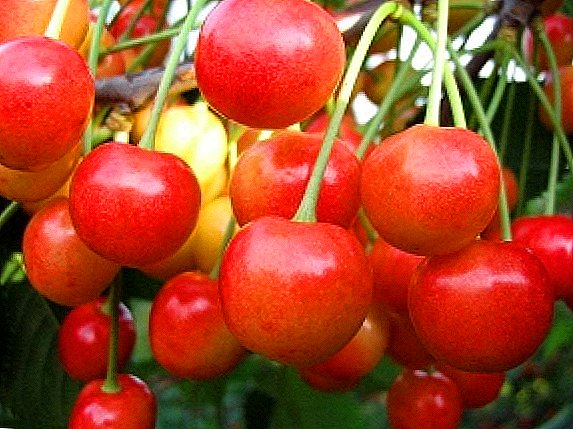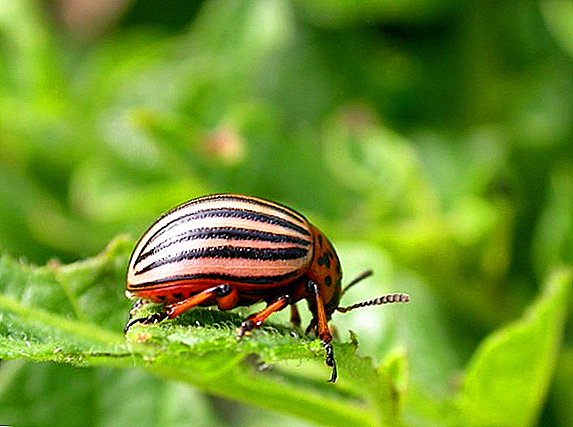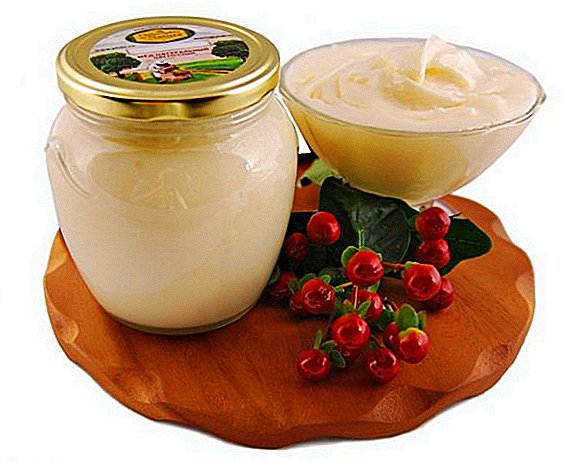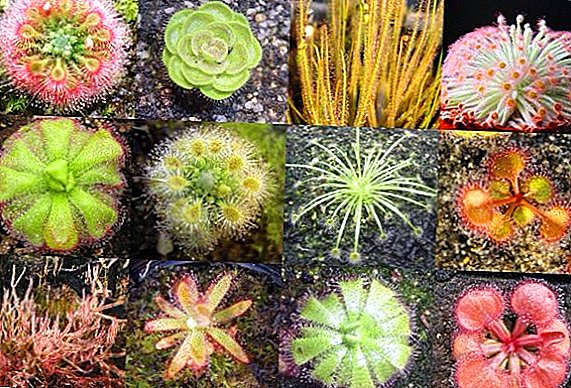 Sundew - a dangerous plant for insects, popularly known as the "charming killer." This is a perennial carnivorous grass with oblong leaves collected at the root in a thick rosette. Along the edges and on the upper surface of the sundew leaves are large, glandular hairs, tentacles, which, when touched, are irritated and release sweet, sticky mucus to catch insects. As soon as the insect lands on sticky hairs, they begin to move, the leaf curls and absorbs the prey. Today, science knows about 190 species of sundew, which grow in all parts of the world, except Antarctica. Some species of this herb are grown as indoor, ornamental plants.
Sundew - a dangerous plant for insects, popularly known as the "charming killer." This is a perennial carnivorous grass with oblong leaves collected at the root in a thick rosette. Along the edges and on the upper surface of the sundew leaves are large, glandular hairs, tentacles, which, when touched, are irritated and release sweet, sticky mucus to catch insects. As soon as the insect lands on sticky hairs, they begin to move, the leaf curls and absorbs the prey. Today, science knows about 190 species of sundew, which grow in all parts of the world, except Antarctica. Some species of this herb are grown as indoor, ornamental plants.
Did you know? Rosyanka herb has medicinal properties and is used in homeopathy, as well as in traditional medicine for cough, whooping cough, fevers, eye diseases, to eliminate warts, etc. In Italy, Rosolio liqueur is prepared from sundew.
All-round sunflower
The sundew is round-leaved - one of the predator flowers, also known by the popular names for God's dew, solar dew, royal eyes, rosichka, rositsa. The plant has basal leaves with a rounded leaf plate, which is framed by red tentacle hairs, consisting of a stem and a secretory gland, secreting sticky mucus. Stem up to 20 cm with a brush of white flowers and the fruit in the form of a single-nesting box. It blooms in the middle of summer.  The sundew round-leaved is most often found on peat bogs in temperate climatic zones of North America, Asia, and Europe. This type is propagated by seeds that are harvested in the fall and sown in a greenhouse on the surface of a moist, peaty soil. For medicinal purposes, the land part of the round-leaf sundew is used., which contains tannins and dyes, organic acids, derivatives of naphthoquinone, ascorbic acid. Apply the plant as an expectorant when coughing, including reflex.
The sundew round-leaved is most often found on peat bogs in temperate climatic zones of North America, Asia, and Europe. This type is propagated by seeds that are harvested in the fall and sown in a greenhouse on the surface of a moist, peaty soil. For medicinal purposes, the land part of the round-leaf sundew is used., which contains tannins and dyes, organic acids, derivatives of naphthoquinone, ascorbic acid. Apply the plant as an expectorant when coughing, including reflex.
Kapian Rosyanka
Cape or home sundew - one of the most beautiful views of this family. It has a short stem, thin elongated leaves and many beautiful white flowers. In general, the plant can reach a height of up to 12 cm. Nevertheless, the Cape sunworm is exactly the same predator as other representatives of this species. It has atypical white tentacles-hairs with droplets of mucus at the ends, with which it absorbs prey. Rosyanka grows Kapa all year round and can adapt to almost any conditions. 
Intermediate sundew
Insectivorous perennial plant sundew intermediate grows in the peat bogs of Eastern Canada, USA, Cuba, Dominican Republic, Guyana, Suriname, Venezuela, Brazil, and also practically throughout Europe. Reaches a height of 5-8 cm, has arcuate curved reverse lanceolate forms, leaves collected in a rosette.  The leafy surface of the intermediate sundew is the same as that of others, covered with numerous red hairs with glands, at the ends of which droplets of mucus are located to swallow insects. The plant blooms in July-August in small white color. This type of sundew is considered the easiest to care for and grow and does not require a rest period. The sundew intermediate is entered in the Red Book of Ukraine.
The leafy surface of the intermediate sundew is the same as that of others, covered with numerous red hairs with glands, at the ends of which droplets of mucus are located to swallow insects. The plant blooms in July-August in small white color. This type of sundew is considered the easiest to care for and grow and does not require a rest period. The sundew intermediate is entered in the Red Book of Ukraine.
English sundew
The English sundew is a poisonous member of the Rosyank family, which grows in Central Asia, the Caucasus, almost all regions of Belarus, Ukraine, Russia, and also on the Hawaiian Islands. Plant height varies from 7 to 25 cm. It has thin long-petiolate, lanceolate leaves, reaching 10 cm in length and directed upwards.  Flower of sundew English - white; the fruit is a single nesting box with seeds of a grayish and brown hue. It blooms typically in mid-summer, prefers wet, sandy and sphagnum swamps. English sundew contains ascorbic and organic acids, naphthoquinones, an anthocyanin enzyme and a proteolytic enzyme similar to pepsin. The healing properties of this plant are often used in medicine, The plant has a bactericidal, antipyretic, anti-inflammatory, diuretic, antispasmodic, expectorant and sedative effect.
Flower of sundew English - white; the fruit is a single nesting box with seeds of a grayish and brown hue. It blooms typically in mid-summer, prefers wet, sandy and sphagnum swamps. English sundew contains ascorbic and organic acids, naphthoquinones, an anthocyanin enzyme and a proteolytic enzyme similar to pepsin. The healing properties of this plant are often used in medicine, The plant has a bactericidal, antipyretic, anti-inflammatory, diuretic, antispasmodic, expectorant and sedative effect.
Important! In medicine, the whole terrestrial part of the sundew is used in English, however, the blackened and dark-brown grass is strictly prohibited to use because of its high toxicity.
Rosyanka disyllabic
The sundew in the wild is found in the southern coastal regions of Australia: from Fraser Island in Queensland, through the states of New South Wales and Victoria to Tasmania Island, and also in South Australia.  Also, this species grows in New Zealand, on Stewart Island and in the Chattem Archipelago. Some populations of sundews dyslozhnoy grow and bloom all year round with small white flowers, while others become dormant in winter. This species has a unique difference from other deer deer - narrow, branching, forked leaves, as evidenced by its scientific name - binata. Besides, it is the largest representative of the genus - the height of the sundew of the disyllabic can reach 60 cm.
Also, this species grows in New Zealand, on Stewart Island and in the Chattem Archipelago. Some populations of sundews dyslozhnoy grow and bloom all year round with small white flowers, while others become dormant in winter. This species has a unique difference from other deer deer - narrow, branching, forked leaves, as evidenced by its scientific name - binata. Besides, it is the largest representative of the genus - the height of the sundew of the disyllabic can reach 60 cm.
Rosyanka Alicia
Alicia's sundew is a subtropical species of sundew whose birthplace is South Africa. The leaves of this species are unusual, shaped like a small plate, the surface of which is covered with numerous tentacles with drops of mucus on the tips. Also, Alicia's sundew has extremely sensitive hairs on the leaves, which at the slightest touch come into action, curving and pulling the victim to the center of the leaf. Gradually the leaf closes around the insect and turns into a kind of small stomach. When the food is digested, the leaf returns to its former form. The plant has racemes and blooms in small pink color. 
Rosyanka Burmana
Sundew Burman in nature is found in a subtropical climate, in Southeast Asia and Australia. It has short stems and wedge-shaped leaves up to 10 cm long, forming a basal rosette. White flowers form high racemes, from one to three per plant.  Well propagated by seeds, has self-pollinating flowers on a long peduncle. This species has one feature that is different from other representatives - it is the fastest sunworm for ingesting an insect. Folding of its leaves around the prey occurs in a few seconds compared to a few minutes or even the hours needed by other types of sundew.
Well propagated by seeds, has self-pollinating flowers on a long peduncle. This species has one feature that is different from other representatives - it is the fastest sunworm for ingesting an insect. Folding of its leaves around the prey occurs in a few seconds compared to a few minutes or even the hours needed by other types of sundew.
Did you know? This type of sundew was named after the scientist Johannes Boorman, who first described it in 1737 in his publication On the Flora of Ceylon.
Rosyanka filamentous
The sundew is filiform - quite a large representative of the genus, reaching 50 cm in height. The leaves are linear and shimmering, erect. Flowers are white, small. This species has two subspecies. The first is a sundew, a filamentary variety Filamentous (Drosera filiformis var. Filiformis), its geographical range is from northeastern Canada, across the United States to the state of Florida, and has two more varieties - Florida All Red (Florida Red) and Florida Giant (Florida Giant ).  The second subspecies, the sundew, the thread-like species of Trais (Drosera filiformis var. Tracyi), grows in the northern part of the coast of the Gulf of Mexico. Thread-like sundew is most at risk in the southern part of the North American range, where sour swamps develop in lowland cereal savannas.
The second subspecies, the sundew, the thread-like species of Trais (Drosera filiformis var. Tracyi), grows in the northern part of the coast of the Gulf of Mexico. Thread-like sundew is most at risk in the southern part of the North American range, where sour swamps develop in lowland cereal savannas.
Sundew hairy
A small carnivorous sundew is a hair-like plant found on the acidic soils of wet pine forests and wetlands in the southeastern United States, as well as in some areas of the Caribbean. It is a small plant from 2 to 4 cm tall, but in wet habitats it can reach 7 cm. The leaves are spoon-shaped and numerous tentacles, and also turn bright red in bright and intense sunlight.  Under normal light, lime-green leaves with red tentacles. Some species of this sundew grow as perennials, others like annual plants and germinate throughout the autumn. The sundew flower is hairy pink, the inflorescences usually appear in April.
Under normal light, lime-green leaves with red tentacles. Some species of this sundew grow as perennials, others like annual plants and germinate throughout the autumn. The sundew flower is hairy pink, the inflorescences usually appear in April.
Did you know? It has been scientifically established that sundew tentacles react only to objects of nutritional value. In contact with the secretory glands of sand, earth, pieces of bark, the folding of the leaves does not occur.
Sunflower sunfly
Sundew sundew grows at an altitude of 1200 m above sea level, on the cliffs and rocky shores of Australia. It has small heart-shaped leaves located on long petioles, which form a rosette with a diameter of about 6 cm. In the cold period, the leaves can change color from green, yellow, orange to red and purple. In the hot season, the leaves remain a typical pale green and yellowish shade. New plants form on the peduncle at the point of contact with the ground and spread very quickly.  In addition to traditional breeding methods, this type of sundew has another, unique asexual method, which is similar to strawberry breeding, when new plants grow on the antennae after flowering. The trap speed of this species is average, it swallows the prey for 20 minutes.
In addition to traditional breeding methods, this type of sundew has another, unique asexual method, which is similar to strawberry breeding, when new plants grow on the antennae after flowering. The trap speed of this species is average, it swallows the prey for 20 minutes.
Glanduliger sundew
Glanduliger sundew has a unique distinctive ability that biologists have recently discovered: a mechanism that throws an insect up. This device works on the principle of a catapult. The method of catching prey in this species is the same as that of its other relatives: sticky mucus on the tips of the tentacles. Different process dynamics: if all other types of sundews wait until their secretory glands begin to contract gradually when they touch the victim in order to pull it towards the center, then the glanduliger itself participates in this process.  This plant insidiously "throws" the victim in the center of the sheet, where it will be impossible for her to get out. This process is carried out using the movement of processes, which, due to changes in fluid pressure at the base of processes, move at lightning speed (16 cm per second). The process is not fully understood; it is only known that such a process only works once. After which he dies, and in its place grows new.
This plant insidiously "throws" the victim in the center of the sheet, where it will be impossible for her to get out. This process is carried out using the movement of processes, which, due to changes in fluid pressure at the base of processes, move at lightning speed (16 cm per second). The process is not fully understood; it is only known that such a process only works once. After which he dies, and in its place grows new.
Rosyanka chereshkovaya
The homeland of the common dewberry is the humid zones of Northern and Western Australia, as well as New Guinea. The leaves are long, narrow, forming a basal rosette in diameter from 5 to 30 cm and up to 15 cm high.  Carnivorous leaf plate is relatively small compared to other species. This is due to the fact that a large plate will require more moisture, which is not enough in conditions of growth of petiolar sundew. The usual temperature regime in which it grows is +30 ° C, it easily withstands temperatures of more than +40 ° C. Flowers are typical white, medium. The peculiarity of this species is that in the wild it can cross independently, which makes it difficult to identify the plant.
Carnivorous leaf plate is relatively small compared to other species. This is due to the fact that a large plate will require more moisture, which is not enough in conditions of growth of petiolar sundew. The usual temperature regime in which it grows is +30 ° C, it easily withstands temperatures of more than +40 ° C. Flowers are typical white, medium. The peculiarity of this species is that in the wild it can cross independently, which makes it difficult to identify the plant.
Limyonica sundew
Limoniferous Sundew prefers heavily shaded sandy areas along creeks of Queensland, Australia. This sundew is characterized by the development of a notch on the top of flat oval leaves, for which it is called a toothed or heart-shaped sundew. Unlike other representatives of the sundew, this species is the most fascinating in the cultivation and care. This is explained by the fact that the schisandra gooseberry has very thin, “paper” leaves that are easily damaged and require high humidity. It also needs a large amount of aeration and a dark place inaccessible to sunlight. 
Sundew flower
Sundew flowers grow in South Africa (Africa), in the provinces of Northern and Southern Cape. It got its name from the flowers of the family Ladannikovye because of the similarity of the inflorescences. The plant is active during the colder months in a wet sandy substrate. In extreme hot and dry conditions in South Africa (November-March), the plant survives by conserving water and nutrients in thick, fleshy and fibrous roots.
 The sundew lozenge flowers reaches a stem height of 40 cm, growing from a leafy rosette. Leaves with a length of 2 to 5 cm do not have petioles, are located directly on the stems. The color of leaves - from yellowish-green to red. Flowers in this species are the largest in the genus, more than 6 cm in diameter, bloom in August and September. The color of the inflorescences also varies greatly in the range from white, pink and orange to crimson and red.
The sundew lozenge flowers reaches a stem height of 40 cm, growing from a leafy rosette. Leaves with a length of 2 to 5 cm do not have petioles, are located directly on the stems. The color of leaves - from yellowish-green to red. Flowers in this species are the largest in the genus, more than 6 cm in diameter, bloom in August and September. The color of the inflorescences also varies greatly in the range from white, pink and orange to crimson and red.
This type of sundew is very changeable, almost every plant has its own shape, height and color of leaves, therefore, it is likely that the type of sundew lozenge color in the near future will be divided into subspecies and varieties.
Did you know? The species has a unique shape, blooming in bright red color, with black veins in the center of the flower, which makes it very similar to the poppy. This is a rare, endangered variant of flowering of dewy-flies flowers, which can only be found near the city of Darling (South Africa).
Rosyanka Horde
Horde sunfly grows on sandy soils in Western Australia. Unlike other types of sundews, it has broad petioles that are densely covered with silvery hairs. The plant forms rosettes of 8 cm in diameter, sometimes reaching 30 cm. The numerous leaves of the sundew of Horde consist of a long, hairy petiole supporting a nearly round leaf plate covered with tentacles. During the dry season the leaves are small and inactive. The plant blooms from December to April, the flowers can be from pink to white, about 1.5 cm in diameter. The plant does not withstand frosts, requires a lot of light, the optimum temperature for it is + 18 ... +30 ° C. 
Rosyanka bulbous
The sundew bulbous is a broad-leaved, tuber-like, small plant, reaching 6 cm in diameter. The color of the leaves changes by the end of the growing season from pale green to golden yellow, sometimes red. This species grows in Western Australia, where it is endemic. Typically grows with a rosette with white flowers that appear from April to June. Differs in the presence of yellow pollen and stems that form the annular space (crown) around the open top of the ovary.
Did you know? Since ancient times, peoples of different countries have made up legends about sundews and other carnivorous plants - the monsters of the vegetable kingdom, which eat animals and even people. Among serious scientists were also "eyewitnesses" who allegedly saw how a small plant was digesting animals. One of these legends was described by a pastor and missionary Karl Likhe in 1880 in an American magazine, after which it spread throughout the world.












